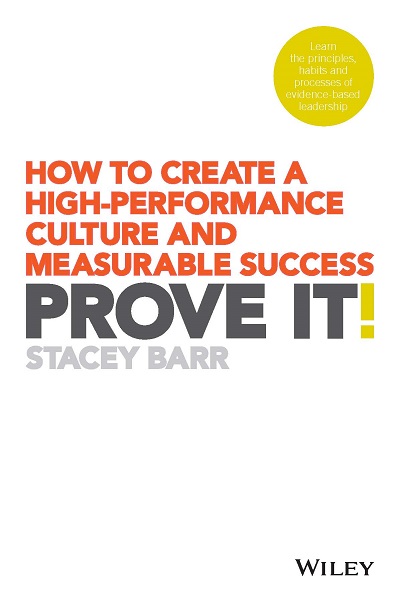What is the Tipping Point Toward a High- Performance Culture?
by Stacey Barr |A high-performance culture smooths the way to achieving organisational outcomes. And good measurement is the tipping point that smooths the way to creating a high-performance culture.

The CEO and senior leaders of any organisation have two high-priority duties, which only they can perform: building culture and setting strategic direction. And these two duties are intrinsically connected in high-performance organisations, organisations that achieve the outcomes they exist to achieve.
In their article “The Leader’s Guide to Corporate Culture”, Groysberg et al discuss that the link between culture and outcomes matters:
“When aligned with strategy and leadership, a strong culture drives positive organizational outcomes.”
This advice isn’t too hard to accept. The hard part is how to get that alignment between culture and strategy and leadership.
A high-performance culture must first align to strategy and leadership.
No matter the style of culture that an organisation has, almost certainly the leaders want that culture to be high-performance; they want the culture to smooth the way to those organisational outcomes of reaching goals, fulfilling the mission and realising the vision.
There are four levers to help a culture to shift, suggested by Groysberg’s and fellow authors’ research:
- “Articulate the aspiration.” Understanding the organisation’s current culture styles, how much it aligns to the organisation’s context, and describing the target culture styles to shift to that will increase the alignment.
- “Select and develop leaders who align with the target culture.” Training, educating, coaching, mentoring and recruiting leaders who believe in and support the aspiration.
- “Use organizational conversations about culture to underscore the importance of change.” Deliberately and regularly talking about the organisational outcomes that matter and the cultural styles needed to smooth the way to achieve them.
- “Reinforce the desired change through organizational design.” Using the organisation’s structure, its business process design, performance management systems, training, and so on, to embed attitudes and behaviours of the target culture.
The scope of work to implement these four levers feels daunting.
Overwhelming, even.
Possibly to the point of tossing it to the “too hard” basket.
But I think there’s another way.
Measurement can be the tipping point toward a high-performance culture.
In Prove It! I proffer that good performance measurement is the tipping point toward a high-performance culture. Done well, performance measurement is a process that holds the space for all four of Groysberg and his colleagues’ levers for evolving culture.
Done well, performance measurement holds the space for people at all levels in the organisation to:
- Think more deliberately and deeply about the results that matter – good measurement practice starts with conversations that translate weasely, fluffy, vague, high-level goals into clear and concise and easily understood goals.
- Have a clearer and unanimous focus on results that matter – when good measurement practice starts with the senior leadership, teams have a starting point they understand, and can more easily see what their contribution is, and therefore what their own goals ought to be.
- Focus people on improving processes and not defending turf – good measurement practice focuses measures on process results and not on people’s results, and this takes the judgment away so people can open up to the truth about performance rather than hiding problems for fear of blame.
- Get objective feedback that is relevant to the strategy – good measurement practice provides just the right amount of evidence about performance so that decisions are made cleanly (without distraction and argument) and quickly lead to action.
- Collaborate across the white space in the organisational chart – good measurement practice encourages a systems view of organisational operations and processes, which is the only way that the root causes that constrain organisational performance can be uncovered and resolved
But, measurement has to be done well to cause the tip toward a high-performance culture.
The ways most organisations do performance measurement won’t work. There are too many bad habits that have become common practice.
And too many people fail to appreciate that measurement needs a methodology or proper approach. It’s not enough to draw a strategy map and populate it with off-the-shelf KPIs (no matter how famous the person is who recommends them might be).
The journey, the process, the experience of measurement needs certain qualities to cause the tip toward a high-performance culture:
- Everyone needs to be involved in the thinking about what the strategy (the goals) really mean, and how they will cascade from the top to their team – leaders should never dictate a team’s goals, but only make the higher order goals clear and understandable.
- The thinking must be open, without filtering or judgment because it’s too easy for people to dismiss ideas that don’t come from the leader, or that challenge the way things have always been done, or that feel uncomfortable or scary or challenging.
- Measure selection must generate ownership and excitement in the people that will create and use the measures to improve performance, which is why it’s useless to have consultants or advisors produce or choose a set of measures for a team – the team must do it themselves.
- The measurement process must have rigour and practicality so that people can learn it, assess how well it’s working for them, master the implementation of it, and trust it enough to make it part of their “real work”.
Prove It! lays out the recipe to achieve this. It’s the leader’s handbook for creating a high-performance culture, one step at a time, at a pace that the current culture can absorb.
Good performance measurement practice is the tipping point that smooths the way to creating a high-performance culture.
[tweet this]
SOMETHING TO THINK ABOUT:
What does measurement currently mean in your culture? Does that support high-performance?
Connect with Stacey
Haven’t found what you’re looking for? Want more information? Fill out the form below and I’ll get in touch with you as soon as possible.
167 Eagle Street,
Brisbane Qld 4000,
Australia
ACN: 129953635
Director: Stacey Barr





